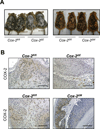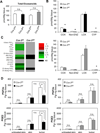Targeted deletion and lipidomic analysis identify epithelial cell COX-2 as a major driver of chemically induced skin cancer
- PMID: 25063587
- PMCID: PMC4233191
- DOI: 10.1158/1541-7786.MCR-14-0397-T
Targeted deletion and lipidomic analysis identify epithelial cell COX-2 as a major driver of chemically induced skin cancer
Abstract
Pharmacologic and global gene deletion studies demonstrate that cyclooxygenase-2 (PTGS2/COX-2) plays a critical role in DMBA/TPA-induced skin tumor induction. Although many cell types in the tumor microenvironment express COX-2, the cell types in which COX-2 expression is required for tumor promotion are not clearly established. Here, cell type-specific Cox-2 gene deletion reveals a vital role for skin epithelial cell COX-2 expression in DMBA/TPA tumor induction. In contrast, myeloid Cox-2 gene deletion has no effect on DMBA/TPA tumorigenesis. The infrequent, small tumors that develop on mice with an epithelial cell-specific Cox-2 gene deletion have decreased proliferation and increased cell differentiation properties. Blood vessel density is reduced in tumors with an epithelial cell-specific Cox-2 gene deletion, compared with littermate control tumors, suggesting a reciprocal relationship in tumor progression between COX-2-expressing tumor epithelial cells and microenvironment endothelial cells. Lipidomics analysis of skin and tumors from DMBA/TPA-treated mice suggests that the prostaglandins PGE2 and PGF2α are likely candidates for the epithelial cell COX-2-dependent eicosanoids that mediate tumor progression. This study both illustrates the value of cell type-specific gene deletions in understanding the cellular roles of signal-generating pathways in complex microenvironments and emphasizes the benefit of a systems-based lipidomic analysis approach to identify candidate lipid mediators of biologic responses.
Implications: Cox-2 gene deletion demonstrates that intrinsic COX-2 expression in initiated keratinocytes is a principal driver of skin carcinogenesis; lipidomic analysis identifies likely prostanoid effectors.
©2014 American Association for Cancer Research.
Conflict of interest statement
No potential conflicts of interest were disclosed by the authors.
Figures







References
-
- Donaldson MR, Coldiron BM. No end in sight: the skin cancer epidemic continues. Semin Cutan Med Surg. 2011;30:3–5. - PubMed
-
- Schwarz M, Munzel PA, Braeuning A. Non-melanoma skin cancer in mouse and man. Arch Toxicol. 2013;87:783–798. - PubMed
-
- Kemp CJ. Multistep skin cancer in mice as a model to study the evolution of cancer cells. Seminars in cancer biology. 2005;15:460–473. - PubMed
-
- Balmain A, Brown K. Oncogene activation in chemical carcinogenesis. Adv Cancer Res. 1988;51:147–182. - PubMed
Publication types
MeSH terms
Substances
Grants and funding
LinkOut - more resources
Full Text Sources
Other Literature Sources
Medical
Molecular Biology Databases
Research Materials

